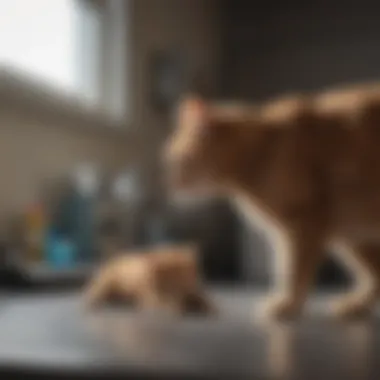Effective Cat Flea Treatments: A Vet's Perspective


Intro
Fleas are pesky little critters that can turn your beloved feline's life upside down. These tiny parasites not only cause discomfort to your cat but can also lead to serious health issues if left unchecked. Understanding the options available for flea treatments at veterinary clinics is essential for every cat owner. That's why we're diving deep into the various methods, effectiveness, and critical considerations when dealing with flea infestations in cats.
This article covers a wide range of topics, from the types of treatments available to the long-term effects of fleas on your cat’s health and well-being. It's not just about choosing a treatment; it’s about making informed decisions that will keep your furry friend comfortable and healthy. By the end, you will have a thorough understanding of the complexities involved in managing fleas and the invaluable role of veterinary expertise in ensuring your pet receives the best possible care.
Animal Species Profile
Preamble to the Animal Species
Cats are cherished companions known for their independence and unique personalities. With a wide variety of breeds, from the majestic Maine Coon to the playful Siamese, cats come in different shapes and sizes, each with their own behavioral quirks and appearance.
Physical Characteristics and Appearance
A cat's appearance can range dramatically, but some common characteristics include sharp whiskers, agile bodies, and keen eyes. These features make them excellent hunters, capable of catching small pests, albeit sometimes being the ones infested with fleas themselves.
Natural Habitat and Distribution
Domesticated cats are found in almost every corner of the globe, a testament to their adaptability. Originally wild creatures from ancient civilizations, they have tailored their living habits to coexist with humans while still retaining their natural instincts.
Behavior and Social Interactions
Cats exhibit a fascinating blend of independence and sociability. They communicate through body language, vocalizations, and even scent marking. Understanding these interactions helps pet owners grasp their feline friend's moods and needs, which is crucial when managing any health issues like fleas.
Implications of Untreated Flea Infestations
Untreated flea infestations can lead to a host of complications such as anemia, skin infections, and even tapeworms. These health issues stem from fleas feeding on your cat's blood, causing weakness and discomfort. A serious flea infestation can drastically affect your cat’s overall quality of life.
"Regular veterinary check-ups can help catch flea infestations early before they spiral out of control."
Vet Consultation and Treatment Options
Types of Flea Treatments Available
Veterinarians offer a variety of treatments for flea management, each with its pros and cons. Some of the common options include:
- Topical treatments: These are applied directly to the skin and can provide immediate relief. Products like Frontline or Advantage are popular choices.
- Oral medications: Pills that target fleas’ life cycle, helping to eliminate them from your pet entirely. A well-known option is Capstar.
- Flea collars: Designed to provide long-term protection, though their effectiveness can vary.
- Professional flea treatments: Sometimes, a vet may recommend a more aggressive approach involving flea bombs or sprays for your home, targeting infestations at every stage.
Factors to Consider When Choosing Treatment
When selecting a flea treatment, consider the following:
- Your cat's age and health: Young or sick cats may require gentler treatments.
- Environment: If your home has multiple pets or is prone to flea infestations, a more comprehensive approach may be necessary.
- Frequency of infestations: Having a plan for regular prevention can save you headaches later on.
Working Together
Choosing the right flea treatment for your cat is a task best undertaken with your veterinarian’s guidance. They can create a tailored plan based on your pet’s needs. It's not just about relieving the immediate annoyance of fleas but also about providing a healthier, happier life for your feline friend.
Navigating the maze of flea treatments at the vet might seem overwhelming at first. However, with accurate information and solid veterinary support, pet owners can successfully keep these troublesome pests at bay.
Preface to Flea Infestations in Cats
Flea infestations in cats can be far more than just an annoying problem; they can affect a cat's overall health and well-being. Understanding the dynamics of these pests is crucial for pet owners who want to ensure their feline friends remain comfortable and healthy.
The Prevalence of Fleas
Fleas are ubiquitous, and they thrive in a variety of environments. According to veterinary studies, it’s estimated that more than 60% of households with pets face flea issues at least once a year. These pests are not picky about their hosts; they can latch onto all kinds of animals, and cats are particularly vulnerable due to their lifestyle and grooming habits. Fleas can spread quickly, especially in multi-pet homes or where outdoor access is available.
Key factors contributing to flea prevalence include:
- Seasonal changes, especially warmer months, when these pests thrive.
- Lack of preventive measures, which often leads to infestations.
- Clutter and debris around the home, offering hiding spots for fleas and their eggs.
Signs of Flea Infestation
Recognizing the signs of flea infestations early can save your cat from discomfort and prevent a wider infestation in your home. Some common symptoms to look for include:
- Excessive Scratching: If your cat is scratching more than usual, this could be a clear indication of flea discomfort.
- Flea Dirt: This is essentially flea feces, resembling tiny black specks, often found in your cat's fur or on their bedding.
- Biting or Chewing on Skin: If your cat is persistently biting or chewing certain areas of their body, it’s time to investigate for fleas.
- Hair Loss or Skin Irritation: Over time, flea bites can lead to hair loss and irritated skin, which may require veterinary attention.
If you're seeing any of these signs, consider scheduling a visit to your veterinarian immediately. Early detection is key for effective treatment.


By understanding these elements related to flea infestations, you equip yourself with necessary knowledge for tackling this common but serious issue. It's not just about the discomfort fleas cause; untreated infestations can lead to severe health problems in pets, including anemia and allergic reactions. This article will delve further into how to deal with these pests through effective treatments and preventive measures.
Understanding Cat Fleas
The significance of understanding cat fleas can't be overlooked, as they pose a serious threat to the comfort and health of our feline friends. When pet owners grasp the intricate life cycle and health impacts of fleas, they are better armed to tackle infestations effectively. Fleas aren’t just annoying little pests; they can facilitate a chain reaction affecting not only the cat's well-being but also the household environment.
"An ounce of prevention is worth a pound of cure." This old adage rings especially true in the world of pet care.
In this section, we will explore two crucial aspects concerning cat fleas: their life cycle and the impact they have on cat health. This insight is essential for implementing preventative measures and for understanding the vital role of professional treatments.
Life Cycle of the Flea
Fleas have a life cycle that consists of four main stages: egg, larva, pupa, and adult. This cycle can be fast, sometimes completing in as little as two weeks. Each stage plays a pivotal role in their proliferation, making understanding the lifecycle necessary for effective control.
- Egg Stage: A female flea can produce around 50 to 100 eggs a day. These white, oval-shaped eggs fall from the host animal into carpets, bedding, and furniture.
- Larval Stage: Eggs hatch into larvae in about 2 days to 2 weeks, depending on conditions. Flea larvae are small, light-colored, and prefer dark places. They feed on organic debris, including flea feces, which consists of digested blood.
- Pupal Stage: The larvae enter a cocoon and become pupae. This stage can last from a week to several months, depending on environmental conditions. Fleas in cocoons can remain dormant until they sense a host nearby.
- Adult Fleas: Once they emerge, adult fleas will quickly look for a host to start feeding on. This starts the cycle all over again, so pet owners may need to take measures at each life stage to disrupt it.
Understanding this life cycle helps in selecting the right treatment and knowing when to apply it. For instance, if treatment is applied just to the adult fleas, the problem might persist if the eggs and larvae are still breeding in the environment.
Impact of Fleas on Cat Health
The repercussions of flea infestations on cats can be severe and far-reaching. Beyond the constant irritation of bites, fleas can lead to a host of health issues:
- Allergic Reactions: Some cats suffer from flea allergy dermatitis, which leads to extreme itching, redness, and sometimes secondary skin infections. A flea bite can trigger a reaction causing the cat significant discomfort.
- Anemia: Fleas feed on blood, and heavy infestations can lead to anemia, particularly in kittens or older cats who are already vulnerable. Fewer red blood cells can mean fatigue and lethargy, making it difficult for the cat to engage in active or normal behavior.
- Transmitting Diseases: Fleas can transmit several diseases, including feline infectious anemia and tapeworms, further complicating health for the affected cat.
In short, the presence of fleas is not just a nuisance but a genuine health concern that should prompt immediate action from pet owners. Staying informed and proactive can help ensure that our cats lead healthy and happy lives, free from the burdensome weight of these tiny invaders.
The Importance of Professional Treatment
When it comes to managing flea infestations in cats, professional treatment plays a pivotal role in ensuring the health and well-being of our furry companions. While home remedies and over-the-counter products might seem like quick fixes, they often miss the mark in terms of effectiveness and safety. Turning to a veterinarian can provide a tailored approach, helping identify the best course of action specific to the cat's needs.
Veterinarians possess the expertise and knowledge to evaluate the unique circumstances surrounding each infestation. One significant benefit of professional treatment is access to prescription medications and treatments that have been rigorously tested for efficacy and safety. The ability to administer these scientifically-backed treatments means that pet owners gain peace of mind, knowing they are pursuing the best option for their pets.
Furthermore, regular veterinary visits allow for a more comprehensive health check. Fleas can lead to more than just itching and discomfort; they can transmit diseases and lead to anemia, especially in kittens or older cats with weakened immune systems. Addressing flea issues promptly with the help of a vet is crucial in preventing these potential complications.
Consultation with a Veterinarian
What to Expect During the Visit
Visiting the veterinarian for a flea problem may feel a tad overwhelming, but understanding what to expect can ease those nerves. Typically, a vet will start with a thorough examination of the cat. This involves inspecting the coat for fleas, flea dirt, and skin irritations.
An essential characteristic of this visit is how personalized it is. Each cat is different, and the vet will often assess not just the cat's immediate problem but also general health and lifestyle habits. This comprehensive approach is invaluable when deciding the best possible flea treatment.
Moreover, the unique feature here is the vet's capacity to prescribe treatments that work by targeting different stages of a flea's life cycle. A one-size-fits-all approach might not cut it in flea treatment, and this tailored selection is a clear advantage of professional consultations.
Key Questions to Ask Your Veterinarian
Arming yourself with questions can turn a veterinary visit from a mere consultation into a valuable exchange of information. Key inquiries might relate to your pet's specific health history, potential side effects of recommended treatments, or the availability of alternative treatment options.
One key characteristic of asking questions is that it fosters better communication with your vet. Opening this dialogue can lead to a more participatory approach to your cat's health care, ensuring that you are an informed advocate for your pet.
The unique aspect of having a list of questions ready is that it encourages clarity. It’s easy to feel dazed during such appointments, and a focused list keeps the discussion on track. This not only saves time but also enhances your understanding of the flea treatments available, making you a proactive part of the solution.
Flea Treatment Options Available at the Vet
Topical Treatments
Topical treatments have become quite a common recommendation for tackling fleas, and for good reason. These treatments are applied directly to the cat's skin, typically between the shoulder blades, allowing for efficient absorption into the system.
One notable characteristic of these treatments is their ease of application. They often come in pre-measured doses, minimizing the risk of under or over-treatment.
A unique feature of topical solutions is their long-lasting effects. Some formulations can provide flea protection for an entire month, simplifying the management process significantly. However, they may not suit every cat—some pets might have reactions to the ingredients, leading to discomfort or skin irritations.
Oral Medications
Oral medications provide a different avenue for flea control, working through systemic treatment options that enter the bloodstream. One of their biggest advantages is that they can be particularly effective in breaking the flea life cycle.
The key characteristic here is that oral medications often function rapidly, eliminating fleas on contact. Their benefit lies in their ability to reach fleas that might be harder to target with topical solutions.
However, the unique aspect is that some cats resist taking pills or chewable tablets, which can pose challenges for owners. Monitoring for possible side effects, like gastrointestinal disturbances, is also crucial after administering oral treatments.
Injectable Solutions


Injectable solutions are a professional option that offers a different approach altogether. Typically administered in a clinical setting, these injections provide long-term relief from fleas, often lasting several months.
An important characteristic of injectable treatments is their convenience. Once given, they usually require little follow-up, unlike topical or oral usually necessitating monthly dosing or reapplication.
A unique feature of injectables is that they ensure compliance, as the cat doesn’t have to interact with the medication directly. However, the downside can include a higher cost and the necessity for a vet visit each time the treatment is needed.
In summary, engaging with professional veterinary services significantly bolsters a cat owner's ability to manage flea infestations effectively.
The variety of treatment choices, tailored to specific needs, illustrates the importance of this proactive stance in ensuring the long-term health and happiness of our feline friends.
Evaluating Treatment Effectiveness
Evaluating the effectiveness of flea treatments is crucial for ensuring the health of your cat. It's not just about applying a product and hoping for the best; it involves careful observation and assessment. This section delves into why it's necessary to monitor treatments and identify any signs of recurrence.
Monitoring for Improvement
Once your cat begins a flea treatment, keeping a watchful eye on its effects is vital. The primary goal here is to determine whether the chosen treatment is effectively reducing flea populations. This can be done through various methods:
- Flea Comb: Regularly comb your cat with a fine-toothed flea comb. This technique allows you to physically remove fleas and their eggs from your cat’s coat.
- Behavior Changes: Monitor your cat's behavior. If your feline friend shows signs of increased comfort, such as less scratching or grooming, it may indicate that the treatment is working.
- Skin Condition: Check for any skin irritations or allergic reactions at the treatment's application site. If the area looks red or inflamed, it might not be the right fit for your pet.
- Consulting Your Vet: Follow up with your veterinarian for professional insights. They may recommend blood tests or additional examinations if necessary.
It’s essential to give the treatment enough time to take effect as some may require a few weeks to show results. During this period, compare your observations with the vet’s guidance to ensure you are on track.
Signs of Recurrence
Just because the treatment appeared successful doesn’t mean the battle against fleas is over. Recurrence can happen, often before you even realize it. Knowing the indicators can help you act swiftly:
- Increased Scratching or Grooming: If you observe your cat scratching more than usual or spending excessive time grooming, it may be a sign that fleas have returned.
- Flea Dirt: This is a telltale sign of flea presence. Look for small black specks on your cat’s skin or in its fur. Flea dirt is essentially flea feces and can be easily mistaken for dirt itself.
- Sensitivity to Touch: If your cat becomes sensitive to touch or avoids physical contact, underlying discomfort could suggest a flea problem.
- New Fleas: Sometimes, fleas can come from untreated areas in your home or habitat. Check each part of your cat's environment, as this can clue you into a recurring problem.
"An ounce of prevention is worth a pound of cure." – Benjamin Franklin
Identifying these signs early on can help prevent more severe infestations from taking root. If you suspect a recurrence, it’s essential to reach out to your veterinarian promptly, as they can assist in determining the next steps. Together with professional guidance, you can effectively manage your cat’s health against fleas.
Preventative Measures Against Fleas
Preventing fleas from taking hold on your cat is far more effective than dealing with an infestation once it starts. These blood-sucking parasites not only disrupt your cat's life but can also lead to severe health issues. Being pro-active is key. When considering flea management, it's crucial to embrace preventative measures that create a barrier against these unwanted pests. A layered approach combining regular veterinary care and meticulous home and yard maintenance can dramatically reduce the likelihood of a flea invasion.
Regular Veterinary Check-ups
Scheduling regular check-ups with your vet is foundational to flea prevention, and for good reason. During these visits, veterinarians not only monitor your cat’s overall health but can also keep an eye out for early signs of flea activity. In fact, many vet practices can provide insights on the latest flea prevention products tailored to your cat's specific needs.
- Tailored Prevention Plans: Vets can create personalized flea control strategies based on your cat’s lifestyle and health history.
- Early Detection: Regular exams facilitate early detection of fleas or any potential side effects from flea treatments your cat might be receiving.
- Interactive Education: These visits are opportunities for pet owners to ask questions and get advice on the best home care practices to keep fleas at bay.
With these check-ups, you’re not just ensuring the health of your cat; you’re also investing in a flea-free future.
Home and Yard Maintenance
Home and yard upkeep are equally vital in the flea prevention equation. Fleas thrive in warm, humid environments, making your home an ideal breeding ground if left unchecked.
- Cleaning: Regular vacuuming is essential. Pay particular attention to carpets, rugs, and the areas where your cat spends most of its time. Don’t neglect corners or under furniture, as these are prime real estate for fleas.
- Wash and Declutter: Washing your cat’s bedding frequently and keeping clutter to a minimum can vastly reduce hiding spots for fleas.
- Outdoor Control: Maintaining a flea-free yard is equally important. Mow your grass regularly and keep bushes trimmed back. Consider using flea repellents approved for outdoor use, especially if your cat enjoys the fresh air.
"An ounce of prevention is worth a pound of cure."
Through diligent home and lawn upkeep, you not only protect your cat but also create a more enjoyable living space.
By investing the time and effort in both professional veterinary partnerships and home care practices, you’ll effectively minimize the risk of flea infestations, keeping your feline friend happy and healthy.
Potential Side Effects of Flea Treatments
Flea treatments are a necessary part of keeping our feline friends healthy and free from pesky infestations. However, understanding the potential side effects of these treatments is crucial for cat owners. Many products work effectively against fleas, but they can also carry risks that deserve attention.
Understanding Adverse Reactions
Every cat is unique, and just like humans, they can react differently to medications and treatments. Adverse reactions can range from mild annoyances to more severe complications. For example, some cats might experience skin irritation, which is often characterized by hyper-sensitivity or rashes in the area where the treatment was applied. This is not uncommon with topical solutions, as ingredients can interact with the cat’s skin or fur.
More serious reactions could include symptoms such as:
- Vomiting
- Diarrhea
- Lethargy
- Seizures
- Loss of appetite
If a pet owner notices these signs occurring after a flea treatment, it is wise to consult with a veterinarian. Understanding the specific ingredients in the flea treatment is also paramount. Different active ingredients can have varied effects. For instance, a spot-on treatment containing Permethrin is particularly dangerous for cats but might work excellently for dogs. Educating oneself about the ingredients in flea control products allows owners to choose safer alternatives that suit their furry companions best.
When to Seek Immediate Vet Assistance


Recognizing when a cat is having a severe reaction to flea treatment can mean the difference between a quick resolution and a serious health crisis. If a cat shows signs of distress or exhibits unusual behavior following treatment, such as:
- Struggling to breathe
- Constant trembling or shaking
- Extreme agitation or anxiety
it is essential to contact a veterinary professional as soon as possible. Immediate response could involve bringing the cat to the clinic or following instructions given over the phone by a vet.
Owners should also heed the advice of their veterinarian about when to report side effects that seem unusual, even if they appear mild. Even certain changes like a persistent scratching habit or excessive grooming can ultimately relay vital information about how the cat is responding to treatment.
Choosing the Right Treatment for Your Cat
When dealing with flea infestations, selecting the appropriate treatment for your cat can feel like navigating a minefield. Each cat is unique, and various factors can overpower one another in significance. This section digs into those nuances to facilitate informed decisions. Cat owners should understand that not every treatment is a universal remedy; it must align with specific elements related to age, health, lifestyle, and environment. This personalized approach can elevate the chances of effectively banishing those pesky fleas while safeguarding your feline's well-being.
Age and Health Considerations
Selecting flea treatments often begins with assessing your cat’s age and overall health. Kittens, for example, have a different set of needs compared to adult or senior cats. Young kittens may only require milder treatments due to their developing immune systems. Conversely, senior cats or those with underlying health issues may be more susceptible to adverse reactions from certain medications.
- Kittens: Generally, flea treatments for kittens are designed to be gentler. Examples include topical treatments and low-dose oral medications made specifically for younger felines. Always consult your veterinarian before starting any new treatment.
- Adult Cats: Healthy adult cats will often tolerate a wider range of treatments, including more potent options. However, it’s critical to observe their initial response to the medication, as reactions can vary.
- Senior Cats: With age often comes more health complications, such as kidney or liver issues. For these cats, be cautious in choosing treatments. Always discuss specific flea products with your vet to ascertain their appropriateness for older cats.
In summary, ascertaining age and health considerations not only ensures the safety of your cat but also maximizes treatment effectiveness. This personalized assessment can be instrumental in reducing potential side effects and enhancing your cat's quality of life.
Lifestyle and Environment Factors
Beyond age and health, a cat’s lifestyle and surroundings are critical elements to consider when deciding on flea treatments. Pet owners should reflect on whether their cat is primarily an indoor or outdoor resident.
- Indoor Cats: Typically, indoor cats have fewer flea exposure risks. However, this doesn’t mean they are immune. Fleas can hitch a ride on humans or other pets. A consistent prevention plan using topical treatments or oral medications is still advisable.
- Outdoor Cats: For cats that roam outside, flea treatments need to be more robust due to higher exposure risks. Options like long-lasting topical treatments may be beneficial, as these can combat reinfestation more effectively. Keeping an eye on your cat after outdoor adventures can help you catch any emerging flea problems early.
- Living Environment: The home environment plays a significant role. Houses with gardens may have a higher flea concentration. Implementing environmental control measures, such as regular cleaning and potentially using flea traps or powders, can complement treatment plans.
Case Studies: Success Stories from Veterinary Practices
Case studies provide invaluable insights into how various treatment approaches can effectively manage cat flea infestations in real-world scenarios. By examining specific instances where veterinarians have successfully treated cats, readers gain a better understanding of the potential outcomes and benefits that can arise from professional interventions. These examples illustrate not only the treatments available but also how various factors such as cat behavior, environment, and health conditions play a crucial role in flea management strategies.
Outcome-based analysis from these case studies reveals patterns and practical strategies that can help cat owners make informed decisions. For instance, the effectiveness of certain treatments may vary depending on the cat's lifestyle or specific flea infestations. This is beneficial knowledge for pet owners who wish to draw on real experiences rather than just theoretical advice.
"Understanding the success stories from veterinary practices offers pets owners hope and assurance that manageable solutions to flea problems exist out there."
In addition to bolstering confidence among cat owners, these narratives can also highlight vital considerations regarding follow-up care and preventative measures. Let’s delve into some specific scenarios.
Effective Treatments for Indoor Cats
Indoor cats often face unique flea challenges, as the controlled environment can sometimes lead to rapid flea population growth. One notable case involved a five-year-old domestic shorthair named Gizmo, who had not been consistently treated for fleas. The owner's initial remedy of over-the-counter spot treatments proved ineffective. After consulting with a vet, a comprehensive approach including a prescription topical treatment and environmental cleaning protocols made all the difference.
The veterinarian recommended:
- Regularly washing bedding and toys to eliminate flea eggs and larvae.
- Vacuuming the home thoroughly and immediately discarding vacuum bags.
- Using a flea comb to help identify and remove any existing fleas.
Within a month, Gizmo was flea-free, highlighting the importance of tailored treatment plans and continued vigilance in indoor environments. These case studies reveal how a combination of prescribed medications and proactive home management can lead to favorable outcomes.
Success in Managing Flea Issues for Outdoor Cats
Conversely, outdoor cats face different sets of challenges with fleas due to their exposure to various environments. Take the story of Whiskers, an adventurous tabby who frequented the neighborhood garden. The cat came back from one of her escapades with a troubling flea infestation. The owners opted for over-the-counter solutions at first, but noticed limited improvement.
After seeking veterinary advice, Whiskers was placed on a multi-faceted treatment plan that involved:
- Long-lasting oral medication that targets fleas at multiple life stages.
- A flea collar designed to repel parasites during her outdoor excursions.
- Education on the importance of flea prevention during warmer months when fleas thrive.
With this comprehensive treatment, Whiskers not only saw a dramatic decrease in flea populations but also enjoyed her outdoor adventures without the unpleasant hitchhikers. This case underlines the critical nature of professional treatments tailored to the unique lifestyle of outdoor cats.
In summary, these case studies showcase how veterinary practices can effectively manage flea infestations through well-planned strategies, emphasizing the role of a tailored approach based on each individual cat's needs and lifestyle.
Closure
In wrapping up our discussion around cat flea treatments, it’s clear that addressing these pesky infestations is crucial for the well-being of our feline friends. Effective flea management hinges on a few key elements that every cat owner should bear in mind.
First, understanding the life cycle of fleas allows pet owners to appreciate why initial treatments are often just the tip of the iceberg. Eggs, larvae, and pupae can linger in your home, making it vital to not only treat your cat but also tackle the surrounding environment.
Secondly, the importance of professional guidance cannot be stressed enough. Veterinary input is invaluable, particularly when it comes to tailoring flea treatments to your cat's specific age, health status, and lifestyle. An informed choice made under vet supervision ensures a more targeted approach, reducing the likelihood of recurrence and potential side effects. Consulting a vet brings not just the advantage of medications available, but also their expertise in monitoring the situation.
It's also worth noting that each cat's response to treatment can vary dramatically, emphasizing the need for monitored follow-ups. Picks from a vet's arsenal can include topical treatments like Frontline or oral medications such as Comfortis, each carrying its pros and cons.
Summary of Key Takeaways
- Flea infestations are not merely an annoyance; they can have serious health implications for your cat.
- Various treatment options are available at veterinary clinics, including topical and oral medications, as well as prevention strategies.
- Regular check-ups with your vet and appropriate home maintenance play significant roles in prevention.
- Early identification of infestations and consistent treatments are key to effective flea management.
The Role of Veterinary Guidance in Flea Management
When it comes to conquering flea issues, the role of a veterinarian transcends mere prescription. A vet serves as a frontline resource, equipped not only with medication knowledge but also with an understanding of how different treatments suit diverse cats. They can guide you through the dusty maze of information regarding adverse effects, which treatments complement others, and when changes need to be made based on your pet's reactions. Moreover, they offer insights into preventative measures fitting your cat's lifestyle—be it indoor or outdoor, active or sedentary.
Veterinary guidance ensures that flea management isn't just about squashing bugs today. It's about establishing a sustainable, long-term flea defense strategy. As a responsible pet owner, investing time into this guidance ultimately helps maintain health and happiness for your cat, assuring that they live a comfortable life, free from the irking nuisance of fleas.







